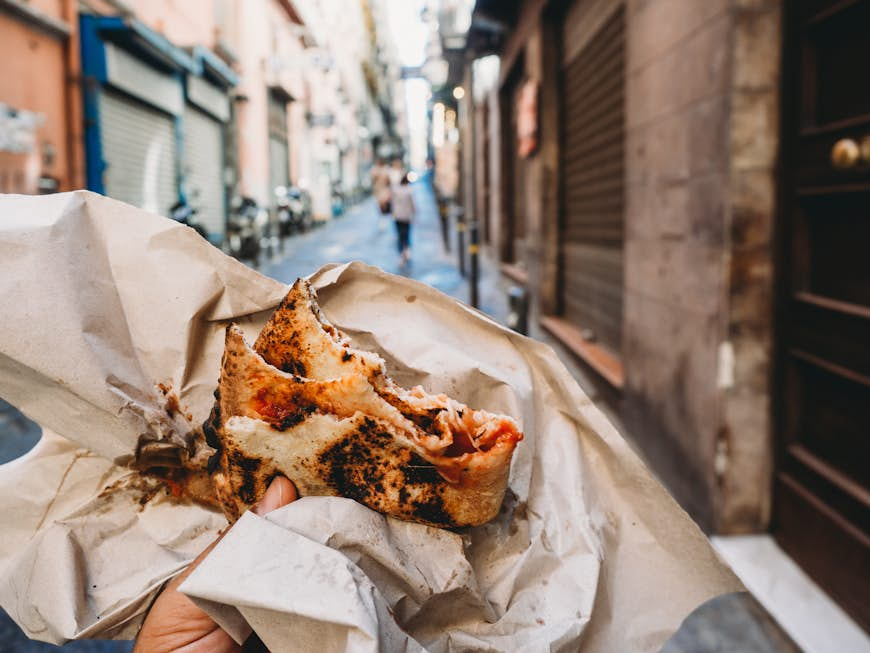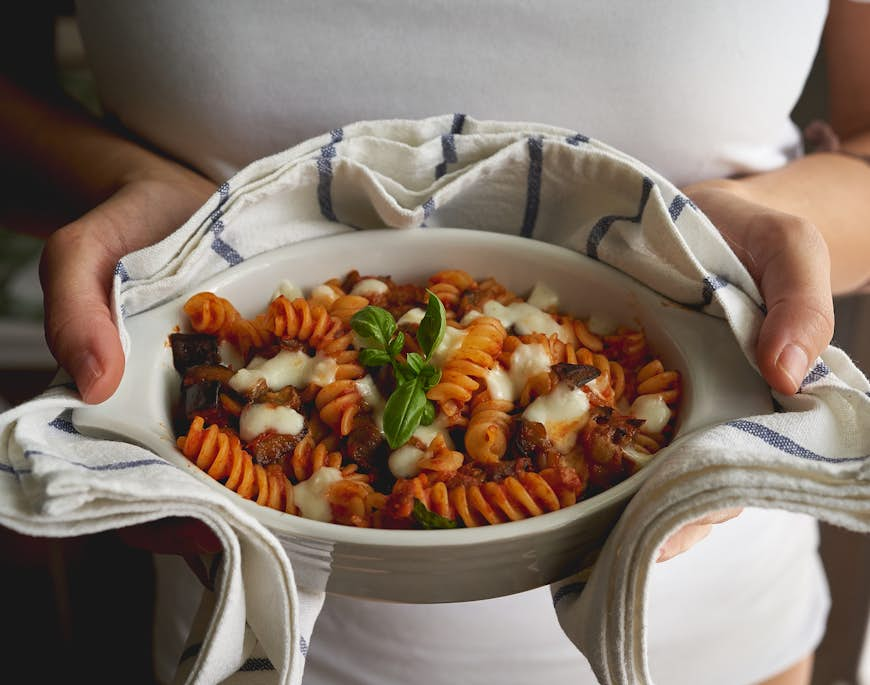
One of the world’s most revered cuisines, Italian food is a handy umbrella term for the country’s cache of regional cuisines. Together they reflect Italy’s extraordinary geographic and cultural diversity. The common thread is an indelible link between food and the locals’ sense of identity. From the quality of Italy’s produce to the reverence for tradition, eating here is all about passion, pride and godere la vita (enjoying life). And devouring these treats is an essential part of any Italian sojourn.
The Italian term for “pride of place” is campanilismo. It’s rooted in the clashes among medieval city-states involving castle sieges and boiling oil, which have been replaced by competition in producing specialty foods and wines.
With such incredible raw material crafted into so many exquisite dishes (and so little time!), fine-tune your culinary radar with the following edible musts. Here’s a start for what to eat and drink in Italy – then get out and explore.
Get the inside scoop on the latest cultural happenings all over the world delivered weekly to your inbox with our email newsletter.  Pasta con le sarde is spaghetti with sardines, parsley, pine nuts and breadcrumbs © beingbonny / Getty Images
Pasta con le sarde is spaghetti with sardines, parsley, pine nuts and breadcrumbs © beingbonny / Getty Images
Embrace an Italian pasta tour
Of course, this delicious mainstay is available and exquisite all over the country, and the experience of sampling all of the regional variations makes any trip worthwhile. In Rome, carb up with spaghetti alla carbonara (no cream involved), bucatini all’amatriciana (with bacon, tomato, chili and pecorino cheese) and spaghetti cacio e pepe (with pecorino cheese and black pepper).
In Bologna, tagliatelle al ragù (pasta with white wine, tomato, oregano, beef and pork belly) is your classic bolognese. The city is also famous for soothing tortellini in brodo (pasta stuffed with ground meats in a thin meat broth).
The town of Gragnano on the Amalfi Coast produces prized pasta perfect for spaghetti alle vongole (spaghetti with clam sauce). Or, in Sicily, go wild with pasta con le sarde (pasta with sardines, pine nuts, raisins and wild fennel).
Uncork a bottle of Sagrantino di Montefalco red and grate a black truffle from Norcia over fresh tagliatelle (ribbon pasta) or strozzapreti (an elongated pasta literally meaning “priest-strangler”).
Sardinian pasta classics include culurgiones (pasta pockets stuffed with potato and casu de fitta cheese), fregola (granular pasta similar to couscous) and malloreddus (a gnocchi-pasta hybrid).
Where to try it: Essenziale in Florence; Da Enzo or Cesare al Casaletto in Rome; Dolceacqua in Olbia, on Sardinia.
 The best place to sample pizza is in its hometown of Naples © FilippoBacci / Getty Images
The best place to sample pizza is in its hometown of Naples © FilippoBacci / Getty Images
Fill your hand, then your mouth with pizza al taglio
“Pizza by the slice” is the perfect piazza-side nibble, and there’s no better place to sample it than Naples, the home of superlative street food. In addition to mainstays (wood-fired crusts topped with prosciutto, basil or mushrooms), creative spins include slider-like annarella – pizza-dough buns filled with artichoke prepared three ways (boiled, creamed and fried) – and provola (provolone cheese), culatello (cured ham) and lemon peel.
Get wild and try pizza fritta (fried pizza dough stuffed with salami, dried lard cubes, smoked provola cheese, ricotta and tomato) while you’re at it.
Where to try it: Concettina Ai Tre Santi, Pizzeria Gino Sorbillo and Starita in Naples.
 Arancini is cheesy, crunchy goodness © Anchiy / Getty Images
Arancini is cheesy, crunchy goodness © Anchiy / Getty Images
Bite into crunchy-chewy arancini and suppli
These deep-fried risotto balls carry several names across Italy, from Rome’s suppli to Sicily’s arancini. Suppli are made with arborio rice and filled with melted mozzarella, hence its full name – supplì al telefono – because the cheese creates long telephone-cord-like strings as you eat it. A version with a porcini mushroom-based filling is nothing to scoff at either. Arancini, on the other hand, got their name because of their small, rounded golden look: like a little orange. These are stuffed with mozzarella, ragù (meat sauce), tomato and usually peas.
Suppli make any wander around central Rome a delight. Small storefronts sell them right onto the street, as do many street markets.
Where to try it: Supplì and Forno Roscioli in Rome; Spinella and Don Tabaré in Sicily.
Let your carnivore have its day
The variations on meat preparations in Italy are deliciously astounding. Bologna piques appetites with mortadella (pork cold cut) and stinco di maiale al forno con porcini (roasted pork shanks with porcini mushrooms). Parma is world-famous for its prosciutto (cured ham), though lesser-known claims include pesto di cavallo (raw minced horse meat with herbs and Parmesan).
Norcia is Italy’s pork capital and is popular for its wild boar. On a similar theme, the Tuscan specialty, pappardelle al cinghiale, is a ribbon pasta with wild boar sauce. Carnivores also drool over Florence’s iconic bistecca alla fiorentina, hailing from Tuscany’s prized Val di Chiana. Sardinia’s interior delivers porchetta (roast suckling pig, often served on a bed of myrtle leaves). And then there’s the classic ossobucco con risotto alla milanese (Milanese veal shank and marrow melting into saffron risotto).
Where to try it: Ristorante Da Muzzicone in Tuscany; Agriturismo Agrisole in Sardinia; I Panini di Mirò in Bologna.
 Mozzarella is best enjoyed fresh © peuceta / Getty Images
Mozzarella is best enjoyed fresh © peuceta / Getty Images
Sample more cheeses than there are villages
Cheese fiends can expect soaring spirits in Italy, home to some of the world’s most esteemed formaggi (cheeses). While there are hundreds of regional creations to nibble on, start with these prized heavyweights:
- Parmigiano Reggiano: A grainy, nutty cheese of DOP (‘Denominazione di Origine Protetta’ or “Protected Designation of Origin”) standing that’s produced in the northern provinces of Parma, Reggio Emilia, Modena, Bologna and Mantua – it’s made using milk from free-range cows on a prized grass or hay diet.
- Gorgonzola: Gloriously pungent, this washed-rind, blue-veined DOC cheese is produced in Lombardy and Piedmont. Made using whole cow’s milk, it’s generally aged three to four months.
- Mozzarella: A chewy, silky cheese synonymous with Campania and Puglia and best eaten the day it’s made. Top of the range is luscious, porcelain-white DOP mozzarella di bufala (buffalo mozzarella), produced using the whole milk of black water buffaloes.
- Provolone: With its roots in Basilicata, this semi-hard, wax-rind staple is now commonly produced in Lombardy and the Veneto. Like mozzarella, it’s made using the pasta filata method, which sees the curd heated until it becomes stringy (filata).
- Asiago:Hailing from the northern provinces of Vicenza, Trento, Padua and Treviso, pungent, full-flavored Asiago DOP uses unpasteurized cow’s milk from the Asiago plateau.
Where to try it: Malvasia all’Adriatico Mar in Venice; Baguetteria de Pace in Puglia; Margutte Polenta da Strada in Turin.
Decide who makes the best gelato in Italy, aka an impossible task
The best Italian gelato uses seasonal ingredients and no synthetic colors, letting the materials set the stage for the look and flavor of the scoop. It’s a perennial battle, where to get the best gelato in Italy…one worth investigating on your own.
Where to try it: Giolitti and Fior di Luna in Rome; Vivoli and Gelateria Pasticceria Badiani in Florence.
 There is no shortage of quality espresso in Italy © Marjan_Apostolovic / Getty Images
There is no shortage of quality espresso in Italy © Marjan_Apostolovic / Getty Images
Start your day with a bang
Most Italian mornings start with a creamy, frothy cappuccino (named for the Capuchin monks, with their brown hoods), which is rarely taken after about 11am and usually served not too hot. Otherwise, it’s espresso all the way, though you could ask for a tiny stain of milk in a caffè macchiato or a cheeky caffè corretto (espresso that’s “corrected” with a splash of grappa or brandy). On the hottest summer days, a granita di caffè (coffee with shaved ice and whipped cream) is ideal. An ever-growing number of Italian bars in both northern and southern Italy now also offer alternatives to cow’s milk, making that cappuccino con latte di soia (soy-milk cappuccino) or latte di mandorla (almond milk) less of an odd request.
Where to try it: Al Parlamento in Venice; Cafè del Binari in Milan; Caffè Sant’Eustachio in Rome – and every other hamlet and city in Italy.
Enjoy Italy’s favorite accompaniment: wine
Wine is a consideration as essential as your choice of dinner date. Indeed, while the country’s perfectly quaffable pilsner beers and occasional red ale pair well with roast meats, pizza and other quick eats, vino is considered appropriate for a proper meal – and since many wines cost less than a pint in Italy, this is not a question of price, but a matter of flavor.
Some Italian wines will be as familiar to you as old flames, including pizza-and-a-movie Chianti or reliable summertime fling pinot grigio. But you’ll also find some captivating Italian varietals and blends for which there is no translation (Brunello, Vermentino, Sciacchetrá) and intriguing Italian wines that have little in common with European and New World cousins of the same name, from merlot and pinot nero (aka pinot noir) to chardonnay.
Many visitors default to carafes of house reds or whites, which in Italy usually means young, fruit-forward reds to complement tomato sauces and chilled dry whites as seafood palate-cleansers. But with a little daring, you can pursue a broader range of options by the glass or half-bottle.
Where to try it: Everywhere!
 Sicilian alla norma is a popular vegetarian dish made with basil, eggplant, ricotta and tomato © Paolo Paradiso / Getty Images
Sicilian alla norma is a popular vegetarian dish made with basil, eggplant, ricotta and tomato © Paolo Paradiso / Getty Images
Vegetarians and vegans
Starter (primi) menus usually include ostensibly vegetarian options, such as pasta con pesto – the classic Ligurian basil paste with Parmigiano Reggiano (Parmesan) and pine nuts – or Sicilian alla norma (with basil, eggplant, ricotta and tomato), risotto ai porcini (risotto with pungent, earthy porcini mushrooms) or the extravagant risotto al Barolo (risotto with high-end Barolo wine, though any good dry red will do). But even if a dish sounds vegetarian in theory, before you order you should ask about the stock used in that risotto or polenta, or the ingredients in that suspiciously rich tomato sauce; there may be beef, ham or ground anchovies involved. And vegans will do battle with the prevalence of cheese in dishes.
Foods worth trying
Missoltini: Como’s sun-dried fish cured in salt and bay leaves.
Lampredotto: Cow’s stomach boiled, sliced, seasoned and bunged between bread in Florence.
Pani ca meusa: A Palermo sandwich of beef spleen and lungs dipped in boiling lard.
Zurrette: Sardinian black pudding made of sheep’s blood, cooked in a sheep’s stomach with herbs and fennel.
Trippa alla romana: Head to Rome’s Testaccio neighborhood for nose-to-tail staples like tripe cooked with potatoes, tomato, mint and pecorino cheese.
A year in food
While sagre (local food festivals) go into overdrive in autumn, there’s never a wrong time to raise your fork in Italy.
Spring (March–May)
Asparagus, artichokes and Easter specialties, plus a handful of festivals like Turin’s Cioccolatò and Ascoli Piceno’s Fritto Misto all’Italiana.
Summer (June–August)
Eggplants, peppers and berries. Tuck into tuna at Carloforte’s Girotonno tuna catch in June and beat the heat with gelato and Sicilian granita.
Autumn (September–November)
Food festivals, chestnuts, mushrooms and game. Truffle hunters head to Piedmont, Tuscany and Umbria, while wine connoisseurs hit Elba’s wine harvest and Merano’s wine festival.
Winter (December–February)
Christmas and Carnevale treats. Fishers serve up sea urchins and mussels on Sardinia’s Poetto beach, while Umbria celebrates black truffles with the Mostra Mercato del Tartufo Nero.



